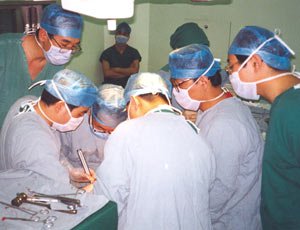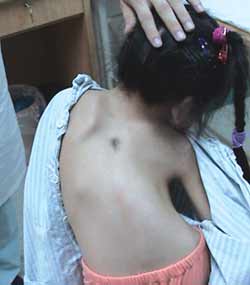Chinese surgeons seek Western technology, expertise and support
Volunteer physicians applaud Asian hosts’ ‘rigorous’ research standards and willingness to improvise.
China, the world’s most populous country, is an emerging front-line player in the world marketplace and a growing force in medicine. With vital links to the West, the Chinese are now learning the latest surgical techniques and getting the newest technology.
![Global Notebook [logo]](/~/media/images/news/print/orthopaedics-today-europe/2006/05_may/globalnotebook_100_119_16895.jpg) American orthopaedic surgeons Myron Spector, PhD; Charles T. Mehlman, DO, MPH; and Alvin H. Crawford, MD, are sharing new approaches with receptive Chinese physicians in Beijing, Shanghai and other areas.
American orthopaedic surgeons Myron Spector, PhD; Charles T. Mehlman, DO, MPH; and Alvin H. Crawford, MD, are sharing new approaches with receptive Chinese physicians in Beijing, Shanghai and other areas.
|
|
Spector, a professor of orthopaedic surgery (biomaterials) at Harvard Medical School, and a group of Chinese physicians formed the Beijing-Shanghai-Boston (BSB) Orthopaedic Education and Research Initiative in 1996. The program involves four major medical centers in China and Harvard Orthopaedics/Harvard Medical International. The program has already staged two major symposia and is planning a third in 2007.
BSB founding members include Spector; Gui-Xing Qiu, MD, chairman of the department of orthopaedic surgery, Peking Union Medical College Hospital; Guo-Wei Rong, MD, president and chairman, department of orthopaedic surgery, Ji Shui Tan Hospital, Beijing Medical University; Shi-bi Lu, MD, chairman of orthopaedics and traumatology, General Hospital of PLA, Beijing; and Ke-Rong Dai, MD, president and chairman, department of orthopaedic surgery, 9th People’s Hospital, Shanghai Second Medical University, and a member of the Orthopaedics Today editorial board.
More than 200 Chinese surgeons attended the second BSB meeting with an “insatiable thirst for knowledge,” Spector noted.
“I have to say the people in China are receptive,” Spector said. “They look for all opportunities to learn. They want to meet the standards in the West with respect to education, and to research as well. So, in their own work, they’re presenting more and more at Western meetings and the rigor of their studies is meeting Western standards as well. ... They are aware of the state of the art when it comes to orthopaedic techniques, procedures and implants.”
In the past, most Chinese surgeons could not attend meetings or receive journals. However, they are now using the Internet to get information on the latest techniques and devices, he said.
The Chinese still lack some of the newest instrumentation, surgical implants and other technologies, but are “very resourceful” and willing to improvise with what they have on hand, Spector noted.
“In some cases, they use more allografts and more autografts instead of off-the-shelf biomaterials,” he said.
Improving industry, regulation
The Chinese are also catching up to the West with homegrown medical technology. For example, Chinese companies are developing and manufacturing hip, knee and other prostheses at a far lower cost than major Western companies.
|
Courtesy of Conrad Wang |
“There are many, many orthopaedic companies producing, artificial hips and knees,” Spector said. “The quality of those implants has improved tremendously. The finishing of the implants [and] the uniformity of the products have improved dramatically.
“There are companies from the West now marketing products in China, no question. On the other hand, there are many products being produced in China, many of which are less expensive than the Western products,” he said.
Chinese patients typically have to pay out-of-pocket for medical devices and sometimes even have to buy the device for the surgeon to use. Patients have also long considered Western products superior to Chinese-made products, but are beginning to see their domestic items improving, Spector noted.
Government regulation is also advancing. The Chinese counterpart of the FDA requires the same pre-clinical trials as the FDA as well as documentation of a product’s safety and efficacy, he said.
“I’ve been impressed and I’ve visited personally some of the government labs doing testing of products,” Spector said. “They’re populated by bright PhDs who are doing studies. The government regulatory agency has developed very nicely. They know what goes on in Europe and the United States with respect to regulation ... and they’re doing the same. It’s very good.”
Spector noted that many Chinese orthopaedic residents do not have enough clinical work and end up doing much more research than many of their American counterparts. That yields a strong research environment, but a lack of surgical experience.
“In our programs, especially in the United States, the residencies are in medical centers that are very busy,” Spector said. “They need the residents to do work in the operating room or in the hospital. In China, it’s not at that point yet. They have many more residents than they can train in clinics, so it means there’s more time for the residents to allocate to research.”
Spector noted that improving economic and living conditions are encouraging more Chinese physicians to live and practice in their homeland. “They have better opportunities in China than they do outside of China,” he said.
Helping heal children
Mehlman, Crawford and other physician and nursing staff from Cincinnati Children’s Hospital Medical Center are collaborating with surgeons from Shanghai Children’s Medical Center to treat Chinese children with scoliosis and other spinal deformities. To date, the volunteers have donated services worth more than $200,000.
Healing the Children, a nonprofit philanthropic organization, sponsors the partnership. Other sponsors have included Medtronic/Sofomor Danek, which donated instrumentation and spinal implants, and DePuy Spine, Mehlman said.
Project Hope, an American philanthropic group, funded the Shanghai Children’s Medical Center.
|
Courtesy of Charles Mehlman |
The Cincinnati surgeons have gone to China twice and plan to take a third trip next fall. On the first trip, the volunteers and their hosts handled mostly trauma cases and some reconstructions. Last year, the group handled more involved cases, such as idiopathic scoliosis.
“Last year, one of my spine anesthesiologists said that taking the spine show on the road is not an easy thing,” Mehlman said. “We did it. We took care of really complicated cases and did very big surgery.”
Last year’s trip included a core group comprising two spine surgeons — Mehlman and Crawford — as well as two spinal anesthesiologists, two spinal nurses, a neurophysiologist/spinal cord monitoring specialist and one pediatrician. This year’s contingent will also include a pediatric pulmonary specialist and pediatric general surgeon. The group plans to focus on congenital and infantile spinal deformities and treat only seven or eight children because of more severe deformities and additional pulmonary demands.
Handling those cases requires top-notch training and current technology, Mehlman noted.
“They’re really hurting for renewable resources and they’re really hurting for training,” he said. “So, to a small extent, we offered them some resources, but we mainly offered them training. We were teaching them video-assisted thoracoscopic surgical techniques and we also taught them the growing rod technique used for very young children with spinal deformity.”
The growing rod technique, used to treat progressive early onset scoliosis, accommodates growth until a child is old enough for fusion surgery.
The volunteers are also using the Vertical Expandable Prosthetic Titanium Rib (VEPTR), a new implant for fused ribs, congenital scoliosis and Thoracic Insufficiency Syndrome, Mehlman said. Instrumentation used with VEPTR is on the verge of winning approval after about one year of review — not a moment too soon, considering the volume and complexity of cases, he added.
“I think they have incredible pathology,” Mehlman said. “It seems like almost every case or every other case is some horrendous spinal deformity from tuberculosis or some congenital scoliosis child who started way off in some rural province and has now made it to a more urban area in China to seek care.”
Noting the Chinese surgeons’ “insatiable desire to learn,” Mehlman recalled his first meeting in Shanghai, where he almost lost his voice from lecturing large audiences.
“Doctors just kept flowing in from different parts of the city and different parts of China, and they just wanted lecture after lecture after lecture,” he said.
“They were hungry for knowledge. Without a doubt, the most well-received gifts that I gave my hosts over the last two years were always textbooks. They were very appreciative.”
Training is the key to further Chinese development in orthopaedics, Mehlman noted.
“One of the most prestigious things that they can do is send their doctors to the States for additional training,” he said. “We’re training our first international fellow this year from Shanghai, Zhigang Wang, MD. He is one of their best surgeons ... and he’s coming to spend six months with us in Cincinnati as an international fellow.”
The Cincinnati Children’s Hospital Medical Center group is a solid core of physicians and specialists strongly bonded to their Chinese hosts and colleagues, Mehlman said. Thanks to ongoing support and international sponsorship, the group plans to visit Shanghai “as long as they want us to keep coming,” he added.
“Our host’s stated goal was to help transform his center into a major spinal referral center in China. He wants to be the best. … He wants to be on the short list of the good centers.”
For more information:
- Hsu H, Spellman MW, Longboy A, Spector M. A Harvard orthopaedics presence in China. Web site: orthojournalhms.org/volume1/html/china.html.

![Charles T. Mehlman, DO, MPH [photo]](/~/media/images/news/print/orthopaedics-today-europe/2006/05_may/mehlman_70_90_16895.jpg)

